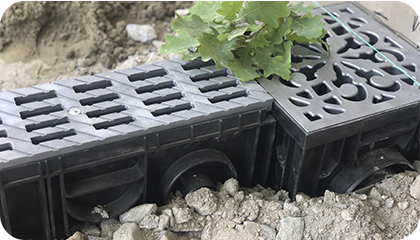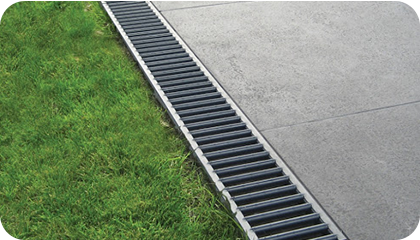In the construction market is now a huge amount of drainage trays for every taste and color. And faces a difficult choice of which channels to choose for yourself, so you do not regret about your choice and to serve for many years.
Let us first define the concept of "drain pans". What is it? What are they?
Drainage trays are designed to drain rainwater and melt water from the site to avoid the destructive action of moisture.
Are channels of rectangular shape, which are interconnected, are connected to the water discharge pipe and top dressed the grille.
Choose drainage trays in the stage of Foundation or have the device blind area near the house or other residential/nonresidential building.
Drainage systems are divided into several types:
- For surface water collection – rain and melt-water
- For collecting water from deep – groundwater abstraction from the site
Drainage system except the tray includes a sand trap, and inlets.
 Trays are:
Trays are:
- plastic
- concrete
- metal
- composite
To go on the appointment grid: plastic, galvanized steel or cast iron.
Now on to our topic for the paper trays. Where to begin your choice?
 Defined by the permissible load for a future drainage system. Based on the purpose and location determine what class the load will be on the tray.
Defined by the permissible load for a future drainage system. Based on the purpose and location determine what class the load will be on the tray.
Depending on the level of loading of the trays are divided into the following groups:
A15 for the local area in the private sector, for garden paths, athletic fields, where the level of allowable load does not exceed 1.5 tons per 1 m2;
В125 installation along roads, which move the cars, load capacity up to 12.5 t;
C250 operation in the service station and the car wash, truck stops, load capacity up to 25T;
Also there are load class D400, E600 and F900 – but it is talking about industrial objects.
If this is the area near the house, garage, utility room, select the tray load the A15. Such trays are offered with durable polypropylene lattice or steel. It is not necessary to overpay and take the trays concrete or metal.
 Bandwidth.
Bandwidth.
The bandwidth of the tray is determined by the settings of the trough: the height and hydraulic section.
!!! The larger the pan, the more bandwidth. Usually carried out the calculation based on the average monthly rainfall increased by 25%.
The amount of precipitation on the working area is calculated according to the following formula:
KO = K*IO*SS
where: CO – precipitation; K – coefficient characterizing the surface features of the basin drain; IO is the intensity of the precipitation; PS — the calculated area of the drain.
|
Surface type |
Ratio |
|
Soil, grass |
0,05-0,36 |
|
Gravel |
0,15-0,3 |
|
Crushed stone |
0,25-0,6 |
|
The blocks overlap |
0,45 |
|
Pavers |
0,6 |
|
Paving with cement connection |
0,8 |
|
Asphalt, concrete |
0,9 |
For example, has a paving with cement compound, K=0,8
The area of flow equal of 200 sq m
Rainfall intensity (for Kiev Q=80L/s per Ha)
TO=0,8(80200)/10 000=1,28 l/s
3. Is the right of the tray. This is also a very important rule, maybe with the improper installation of the client starts to complain about the manufacturer or product. There are actually recommendations for correct installation of trays and what not to do in order not to complicate their work.
Trays from different manufacturers come in a height of from 50 to 210 mm and a width of 100-250mm.
Company of Sampras today are willing to offer drainage trays budget series, but with a long-lasting effect – plastic trays with a height of 50, 75, 100, 120 mm and widths of 100, 125 and 200mm made in Turkey.
 The advantages of plastic tray:
The advantages of plastic tray:
- excellent throughput
- resistance to UV rays
- temperature resistance: application temperature -40.... 500With
- high strength due to the excellent design of the plastic grille or stainless steel 1.5 mm thickness
- long life
- environmentally safe
The result: always when choosing gutters, keep in mind the above facts, and it will help to take away excess moisture from the area and protect Your beautiful Foundation from damage and mould, and the area from flooding.